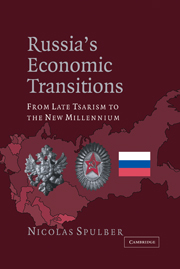Book contents
- Frontmatter
- Contents
- Figures and Tables
- Preface
- PART I THE TSARIST ECONOMIC TRANSITION
- PART II THE SOVIET ECONOMIC TRANSITION
- PART III THE POST-SOVIET ECONOMIC TRANSITION
- 19 The Socioeconomic Framework
- 20 The Transition Issues
- 21 The Economic Policies
- 22 The Problems of Agriculture
- 23 The Industrial Changes
- 24 Domestic and Foreign Trade
- 25 Money and Banking
- 26 State Finance
- 27 Overall View
- Index
22 - The Problems of Agriculture
Published online by Cambridge University Press: 03 December 2009
- Frontmatter
- Contents
- Figures and Tables
- Preface
- PART I THE TSARIST ECONOMIC TRANSITION
- PART II THE SOVIET ECONOMIC TRANSITION
- PART III THE POST-SOVIET ECONOMIC TRANSITION
- 19 The Socioeconomic Framework
- 20 The Transition Issues
- 21 The Economic Policies
- 22 The Problems of Agriculture
- 23 The Industrial Changes
- 24 Domestic and Foreign Trade
- 25 Money and Banking
- 26 State Finance
- 27 Overall View
- Index
Summary
Landholding
This chapter focuses first on the respective positions of Russia's three types of agricultural producers – namely, agricultural enterprises, holders of household plots, and family farms – with respect to their land use, sown areas, and livestock holding. The chapter thus centers its attention on the technological basis of each of the indicated category of producers, and on employment and unemployment in this sector. Given the respective positions of each of the indicated categories of producers with respect to the means of production, I present the results in terms of output and yields and compare them to the achievements of the Group of Seven (G7) industrial countries. After the chapter considers the position of agriculture with regard to exports and imports, the concluding section summarizes the overall sectoral results.
Russia's agricultural population increased slightly through the 1990s, from 39.1 million people in 1991 to 39.5 million in 1999, accounting for 27 percent of the population. Total employment in agriculture decreased during these years from 9.9 million to roughly 8.5 million, accounting throughout the period for around 13 to 14 percent of the total employment, because the latter decreased even faster during those years. The land in use by all agricultural producers amounted to 41 percent of the total land of the Federation, while the arable land accounted for as little as 7.3 percent of the total land.
- Type
- Chapter
- Information
- Russia's Economic TransitionsFrom Late Tsarism to the New Millennium, pp. 329 - 341Publisher: Cambridge University PressPrint publication year: 2003



